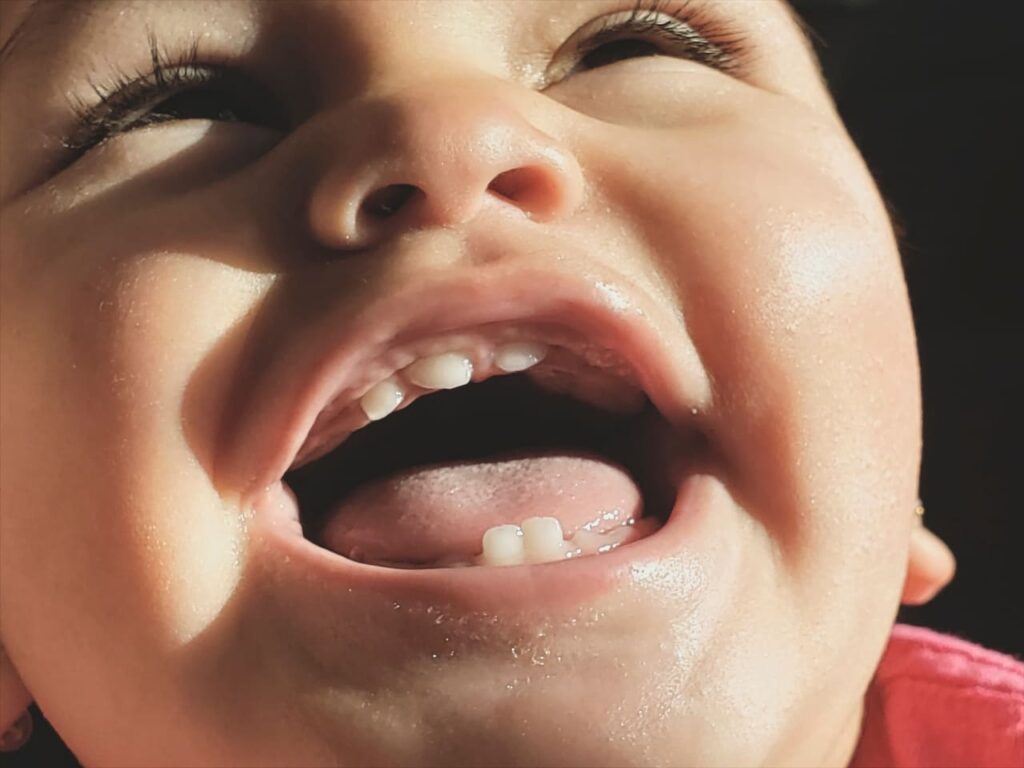Many parents notice a gap between their baby’s front teeth. They start to asking, is this normal? Will it stay?. The medical term for a gap between teeth is “diastema”. Gap teeth in babies are common and a normal part of development.
About half of children under age 6 have a gap between their top front teeth. Most gaps close on their own as a child grows.
Most of the time, a gap is not a problem. Baby teeth are smaller than adult teeth. The extra space helps the bigger teeth come in straight. Still, not all gaps go away. Some stay as your child grows. A few may need a dentist’s help.
This article explains how to spot the difference. You’ll learn what’s normal, what’s not, and when to take action.
In This Article
- How to Spot a Tooth Gap in baby Early
- Why Baby Teeth Are Important
- What Causes Gaps Between Baby Teeth?
- Gap Teeth in Babies: What Is Normal?
- Genetic Factors and Family Traits
- Lip Tie and Upper Frenum
- Thumb Sucking, Pacifiers, and Other Habits
- Jaw Growth and Development
- Signs Your Baby Might Have Gap Teeth
- When to See a Pediatric Dentist
How to Spot a Tooth Gap in baby Early
To spot a tooth gap early in a baby, look for spaces between the front baby teeth. A small gap is common and often helps adult teeth grow in straight. But some gaps may stay or need care.
If your child has trouble feeding or speaking, check their mouth closely. Lift the upper lip and feel for a thick strip of skin between the lip and gums. This may be a lip tie and can cause a lasting gap.
Also, think about habits like thumb-sucking or pacifier use. If these continue past age two, they may push the teeth apart.
Common Signs to Watch:
- Space between front teeth stays wide
- Thick flap of skin under upper lip
- Trouble with feeding or early speech
- Thumb-sucking or pacifier after age two
- Gap stays after adult teeth begin to grow
- You or your partner have gap teeth too
Why Baby Teeth Are Important
You may wonder why baby teeth matter. After all, they fall out one day. But baby teeth help your child every day. They help your child chew food and speak. They also make space for adult teeth later.
Each baby tooth holds a spot in the mouth. This helps adult teeth grow in the right place. If a baby tooth falls out too early, other teeth may move. This can cause crowding or crooked teeth later on.
Taking care of baby teeth keeps your child healthy. It also protects their future smile. So, even if baby teeth fall out later, they still matter a lot today.
What Causes Gaps Between Baby Teeth?
It is common to see gaps in baby teeth. These spaces may look strange, but they are often normal. Most of the time, gaps are a part of healthy growth. They give adult teeth more room to come in straight. In many cases, these gaps go away on their own. You usually do not need to worry.
Gap Teeth in Babies: What Is Normal?
A diastema means there is space between two teeth. Most gaps in young children appear between the upper front baby teeth. A small gap in baby teeth is not a problem for most children. Baby teeth gaps can even be helpful. They make room for the larger adult teeth. Gaps between baby teeth close by themselves with time.
As more teeth come in, they push the front teeth closer together. Many gaps close by age eight or nine. This is when the adult incisors and canine teeth erupt. So a gap during the baby teeth years does not always mean a permanent gap.

Genetic Factors and Family Traits
Family traits play a big role in diastema in children. Parents or siblings with gap teeth can pass this trait to their child. This increases the chance that the child will have gap teeth too. Genes can affect the size of the jaw and teeth.
For example, a child may inherit a large jaw and small teeth from a parent. This mismatch can create extra space and gaps between teeth. In other cases, a child might inherit a small jaw with larger teeth. This leads to crowding, not gaps.
Lip Tie and Upper Frenum
A lip tie is a condition that can cause a gap in a baby’s teeth. The labial frenum is the small flap of skin under the upper lip. A lip tie happens when this frenum is too thick or tight. This tissue can attach low between the front teeth. It can keep them apart.
An upper lip tie can create a visible gap between a baby’s top front teeth. Many infants have some form of lip tie. In most cases, it improves as they grow. The frenum often stretches or moves as more teeth come in. This can let the gap close on its own.
If a lip tie causes feeding or speech problems, see a pediatric dentist. You should also see the dentist if a large gap remains as your child gets older. The dentist will check the lip tie. If needed, they can perform a simple procedure (frenectomy) to release it. In most cases, patience is best. The gap will close on its own with time.
Thumb Sucking, Pacifiers, and Other Habits
Certain baby habits can lead to gap teeth. Two common habits are thumb sucking and pacifier use. Using a bottle for too long can also cause issues. Sucking on a thumb, pacifier, or bottle for a long time puts pressure on the front teeth. This pressure can push the teeth forward. It can create a gap between them.
A long-lasting habit can make the front teeth move more out of place. Another habit is tongue thrusting. This is when a child presses their tongue against the front teeth when swallowing. Over time, it might push the front teeth apart. Parents should wean children off pacifiers and thumb sucking by age two. This protects their tooth alignment.
Jaw Growth and Development
A baby’s mouth and jaw grow a lot in the early years. Jaw growth can change the spacing of the teeth. When babies are young, their front teeth may come in with a gap. This is more likely if the frenum is low. As the child’s jaw grows, the position of that tissue changes. By around one year old, the upper frenum may stretch.
More baby teeth have appeared by then, and they can close some gaps. Kids lose baby teeth and then adult teeth come in. During this time, gaps can open or close. For many children, the adult canine teeth erupt around age 11–12. These teeth push the front teeth together and close the gap.
For most children, a gap in baby teeth will correct itself with normal growth. It will close as permanent teeth come in. Every child is different. In many children, jaw development helps reduce spacing by the time all adult teeth are in.

Signs Your Baby Might Have Gap Teeth
How can you tell if your baby will have gap teeth as they grow? There are a few signs and factors to watch:
- Family history: Check if parents or siblings have a similar gap. A family pattern suggests your baby could have one too.
- Visible lip tie: Lift your baby’s upper lip. If you see a thick piece of tissue between the upper lip and the gums, it could be a lip tie. A strong lip tie can cause a gap in baby teeth.
- Early gap that persists: Check if a wide gap is still there after your baby’s front and side teeth have come in. If the gap stays large as more teeth erupt, it might persist into later childhood.
- Prolonged thumb or pacifier use: If a toddler keeps sucking a thumb or pacifier past age two, it can push the front teeth apart.
- Missing tooth: In rare cases, a tooth might not develop. A missing tooth leaves an empty space and can lead to a gap. Your dentist can check for this if teeth don’t appear as expected.
Having one or more of these signs does not guarantee a permanent gap, but they can be clues. It is helpful to mention any concerns to your child’s dentist so they can monitor the spacing as your baby grows.
When to See a Pediatric Dentist
Regular dental check-ups are important for every child. A pediatric dentist (children’s dentist) can examine your baby’s teeth and gums. They can spot any issues early. See the dentist if you are worried about a large gap in your baby’s teeth. You should also seek advice if you suspect a lip tie. In most cases, dentists suggest watching and waiting. Gaps close on their own as the child grows. However, you should see a dentist sooner if:
- The gap is wide or causing bite problems for your child’s other teeth.
- Your child has difficulty nursing or brushing because of a thick lip frenum (lip tie).
- The gap doesn’t get smaller after more baby teeth come in.
- You suspect a missing tooth or extra tooth is affecting the spacing.
A pediatric dentist can guide you on the next steps. They might track the gap over time. In some cases, they will take an X-ray to check tooth development. If needed, they may refer you to an orthodontist when your child is older. Gap teeth can be corrected with treatments like a frenectomy (to fix a lip tie) or braces. No immediate treatment is needed for a gap in baby teeth.
Conclusion
Gap teeth in babies are a normal part of growing up. Many children have a gap in their baby teeth. It closes on its own as they get older. Know the common causes and signs of gaps. Then you can better tell if your baby might have gap teeth in the future. Remember that each child is different.
Keep an eye on your child’s habits and oral development. You can always ask a pediatric dentist for advice during routine check-ups. Your child’s smile will develop with proper care and time. It will grow in the healthiest way for them.











